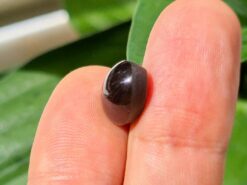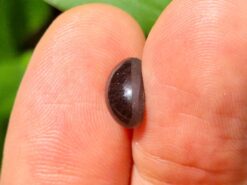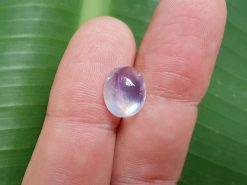Moonstone

Moonstone meaning. The moonstone crystal is often use in jewellery as necklace, ring, earrings, bracelet and pendant.
Buy natural moonstone in our shop
Moonstone is a sodium potassium aluminium silicate with the chemical formula (Na,K)AlSi3O8 and belongs to the feldspar group.
Its name comes from a visual effect, or sheen, due to the light diffraction within a micro-structure consisting of a regular of feldspar layers (lamellae).
We used the stone in jewelry for millennia, including ancient civilizations. The Romans admired this gemstone, as they believed it was born from solidified rays of the Moon. Both the Romans and Greeks associated the stone with their lunar deities. In more recent history. It became popular during the Art Nouveau period. French goldsmith René Lalique and also many others created a large quantity of jewelry using this stone.
The most common moonstone is of the mineral adularia, named for an early mining site near Mt. Adular in Switzerland, now the town of St. Gotthard. The plagioclase feldspar oligoclase also produces stone specimens. It is feldspar with a pearly and opalescent schiller. An alternative name is hecatolite.
Orthoclase and albite
The crystal is composed of two feldspar species, orthoclase and albite. The two species are intermingled. Then, as the newly formed mineral cools, the intergrowth of orthoclase and albite separates into stacked, alternating layers.
Adularesence
Adularescence is a blue sheen phenomena reflecting on the domed cabochon surface of moonstone. The phenomena of shimmer comes from the interaction of light with layer of little “albite” crystals in the stone. While the thickness of layer of these tiny crystals determine the quality of blue shimmer. Therefore, thinner the layer, better the blue flash. This usually appears as a billowy light effect.
Deposits
Deposits occur in Armenia (mainly from Lake Sevan), also Australia, the Austrian Alps, Mexico, Madagascar, Myanmar, Norway, Poland, India, Sri Lanka and the United States.
Furthermore, the moonstone meaning is the Florida State Gemstone (USA). It was designated as such in 1970 to commemorate the Moon landings, which took off from Kennedy Space Center. Despite it being the Florida State Gemstone, it does not naturally occur in the state.
Feldspars
Feldspars are a group of rock forming tectosilicate minerals that make up about 41% of the Earth’s continental crust by weight.
It crystallize from magma as veins in both intrusive and extrusive igneous rocks and are also present in many types of metamorphic rock.
Moonstone meaning and properties
The following section is pseudo scientific and based on cultural beliefs.
As ancient as the moon itself, the meaning of the stone lies within its energy. This power can nourish, give passion, and awaken your feminine energies. It can heal and guide you to your inner path. As ancient as the moon itself, the meaning of the gemstone lies within its energy.
Sample from India
FAQ
What is moonstone good for?
Moonstone meaning enhances intuition, promotes inspiration, success and good fortune in love and business matters. the stone aids the digestive system, assimilates nutrients, eliminates toxins and fluid retention, and alleviates degenerative conditions of skin, hair, eyes, and fleshy organs such as the liver and pancreas.
Is moonstone expensive?
The stone is rare in both large size and fine quality, but Indian material with strong body color is abundant and very inexpensive. This is fortunate, because the material is usually well cut and very attractive. With a blue sheen, the most valuable kind, rarely occurs in sizes over 15 to 20 carats.
Who should wear moonstone?
According to astrology generally it should be worn in small finger of right hand. What day and timethe stone should be worn? For good astrological effects, one should wear the gemstone on Monday morning between 5 am to 7 am in Shukla paksha days.
Is moonstone jewellery good for engagement rings?
Although diamonds are, without doubt, the most popular gemstones for engagement rings, for a couple that want a different, bohemian and more natural look, the moonstone meaning an excellent alternative. The moonstone crystal is often use in jewellery as necklace, ring, earrings, bracelet and pendant.
Can you wear moonstone everyday?
If you want to wear it every day, be sure that it’s fixed securely into the jewelry and it’s better to avoid any physical activity every time you wear it. To get the most benefits from crystal, wearing it in the sterling silver ring is the best way.
Does moonstone protect you?
Some believe it can bring relief from menstrual problems, prevent water retention, cleanse the digestive system, and reduce obesity. Linked with the crown, third eye, and heart chakras, it calms and relieves stress while releasing love of all kinds.
Do blue moonstone glow in the dark?
Light a little path in the dark with a trail of mini moonbeams or add them to a fairy garden for extra nighttime glow. The stone absorb light during the day and glow for up to three hours into the night.
How do you know if moonstone is real?
Adularescence should, ideally, be blue. The sheen should be centered on the top of a cabochon, and it should be easily seen from a wide range of viewing angles. If adularescence is only visible within a restricted viewing range, its value drops. It can be found in a variety of body colors. The moonstone crystal is often use in jewellery as necklace, ring, earrings, bracelet and pendant.
Can moonstone go in water?
Submerging crystals in water or salt water can cause irreversible damage to your crystals. Some examples of crystals that definitely cannot be cleansed in water are all calcite varieties, gypsum minerals, azurite, kyanite And kunzite just to name a few.
Is opal and moonstone the same?
- A sodium potassium aluminium silicate with the chemical formula (Na,K)AlSi3O8 and belongs to the feldspar group.
- Opal is a hydrated amorphous form of silica. Its water content may range from 3 to 21% by weight, but is usually between 6 and 10%.
Is moonstone a real gem?
Yes, it is a real gemstone, a member of the feldspar family that also includes labradorite and sunstone, as well as rainbow moonstone and amazonite. It is made of two minerals: orthoclase and albite, which form in stacked layers within the stone.
Can I wear moonstone to sleep?
It helps to reduce emotional stress, making it easier for our mind and body to fall asleep. The stone was even used in ancient times as a sleeping stone. This stone carries the energy of the new moon, which symbolizes new beginnings. You can also use this stone when going through a rough patch in your life.
Natural moonstone for sale in our gem shop
We make custom made moonstone jewelry as engagement rings, necklaces, stud earrings, bracelets, pendants… Please contact us for a quote.
















